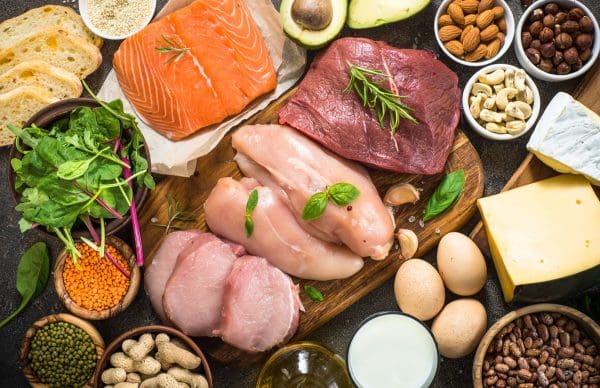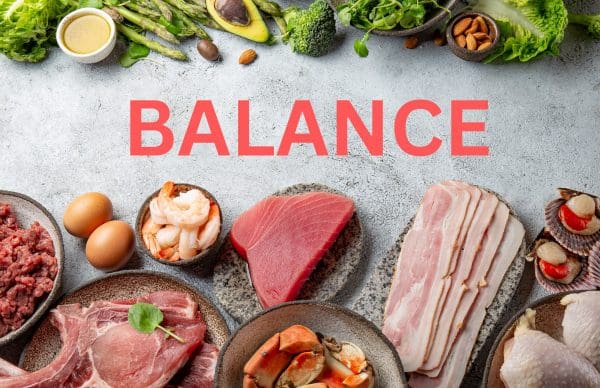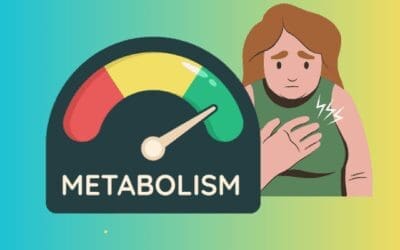As we progress into our 40s and beyond our bodies start going through some changes. One of the most important ones to be aware of is the gradual loss of muscle mass, a process known as sarcopenia. This can lead to decreased strength, balance, and metabolism. But fear not, there’s a powerful tool in our arsenal to combat this: protein!
Beyond its common association with fitness, protein stands out as a pivotal component in maintaining optimal health during the ageing process.
As our bodies undergo natural changes, protein emerges as a key player in mitigating this decline. Serving as the fundamental building block for muscles, bones, and tissues, it assumes a critical role in preservation and repair.
Consider this an opportunity for a constructive dialogue rather than a lecture on nutrition. Our aim is to explore practical and feasible strategies for seamlessly integrating an appropriate amount of protein into our daily routines. So, take a moment, find a comfortable space, and let’s engage in a professional yet friendly discourse on the significance of protein in our overall well-being.
Understanding Protein Needs

How protein plays a role in maintaining muscle mass and overall health
Protein is like the body’s construction crew, diligently working to build and repair the structures that keep everything upright. In our case, these structures are muscles, and as we age, they can use a bit more attention.
See, muscles act as the support system for our bodies, aiding in mobility, posture, and overall strength.
Protein ensures these muscles stay robust, preventing the natural decline that often accompanies the ageing process. It’s like giving your body the tools it needs to maintain its resilience.
How protein needs change with age
Now, here’s where the plot thickens.
Our protein needs aren’t static; they’re dynamic and evolve over time. As the years roll by, factors like hormonal changes and a slower metabolic rate come into play.
These changes mean that our bodies may require a bit more protein to offset the natural wear and tear.
So, it’s not just about meeting the basic protein requirements – it’s about understanding how our bodies, especially our muscles, may benefit from a little extra protein TLC as we gracefully navigate the journey of ageing. Think of it as a tailored maintenance plan for your body’s infrastructure.
Science-Backed Recommendations

So, how much protein do you actually need?
The Recommended Dietary Allowance (RDA) for protein for adults is 0.8 grams per kilogram of body weight per day.
However, for adults over 40, especially those looking to maintain muscle mass or lose weight, 1-1.2 grams per kilogram of body weight is recommended.
Here’s an easy example:
- If you weigh 70 kilograms, the RDA recommendation would be 56 grams of protein per day (0.8 x 70).
- But aiming for 70-84 grams (1-1.2 x 70) might be more beneficial for muscle health.
For individuals over 40 engaged in strength training, the recommended daily protein intake falls within the range of 1.54 – 2.20 grams per kilogram of body weight per day.
Example:
- The same 70kg individual following this recommendation would need 107-154 grams of protein daily.
Specific considerations for those over 40
Now, when it comes to the 40-plus club, as I said earlier – the plot thickens a bit.
As we age, our bodies become less efficient at using protein, leading to a gradual loss of muscle mass (sarcopenia). This necessitates a slightly higher protein intake compared to younger adults to maintain muscle mass, bone health, and overall function.
So, without delving into protein shakes and steaks exclusively, it’s worth considering a moderate increase in your protein game.
Misconception of “one-size-fits-all” protein requirements
But hold on – there’s a common misconception we need to debunk. The idea that everyone, regardless of age or lifestyle, needs the same amount of protein is a bit misleading.
Our bodies are unique, and so are our protein needs.
It’s not a one-size-fits-all scenario. Factors like activity level, health status, and personal goals play a role in determining the ideal protein intake for you.
Remember, this is just a general guideline. Several factors can influence your individual protein needs, including:
- Activity level: People who exercise regularly, especially strength training, may need more protein.
- Muscle mass: Those with more muscle mass naturally require more protein for maintenance.
- Overall health: Certain health conditions may necessitate adjustments in protein intake.
So, the key here is finding your sweet spot – the protein intake that aligns with your individual needs and supports your journey towards a healthier, fitter you.
It’s about customising, not conforming.
Protein Sources

Protein-rich foods suitable for the target audience
Let’s stock our nutritional toolbox with a variety of protein-rich foods. First up, we’ve got lean meats like chicken and turkey – excellent sources of high-quality protein. Fish, especially fatty fish like salmon, bring not only protein but also those omega-3 fatty acids that are great for the heart and brain.
Next on the list are eggs, a budget-friendly protein powerhouse.
If you’re exploring plant-based options, legumes such as beans and lentils are fantastic choices, offering both protein and fibre. Tofu and tempeh, derived from soybeans, are versatile plant-based proteins that can be incorporated into various dishes.
Options that align with mid to higher income budgets
Now, let’s talk budget.
Quality protein doesn’t always have to break the bank. Eggs, for instance, are not only affordable but also incredibly versatile. Canned tuna is another budget-friendly option that packs a protein punch.
For those looking to indulge a bit, Greek yoghurt is a tasty choice that aligns with mid to higher income budgets. It’s not only rich in protein but also brings the goodness of probiotics. Additionally, nuts and seeds, although slightly pricier, are nutrient-dense and offer a convenient snacking option.
Remember, the key is finding a balance that suits your preferences and financial considerations. A mix of these protein sources can provide the variety your body needs to thrive.
Balancing Macronutrients

Importance of balancing protein with fats and carbohydrates
While protein plays a crucial role in supporting your health and fitness journey after 40, it’s not the only player on the team. Fats and carbohydrates also contribute significantly to a balanced and sustainable approach.
Let’s explore how they fit alongside protein in your diet:
Carbs: Fueling Your Body and Brain
Carbohydrates are the primary source of energy for your body and brain. They come in various forms, with complex carbs like whole grains, fruits, and vegetables offering sustained energy and essential nutrients, while simple carbs like sugary drinks and refined grains can lead to energy crashes and blood sugar spikes.
Here’s how carbs can complement your protein diet:
- Provide readily available energy: During exercise, especially high-intensity activities, carbs provide easily accessible fuel for your muscles.
- Support brain function: Complex carbs are essential for cognitive function and mood regulation.
- Enhance fibre intake: Choosing fibre-rich carbs like fruits, vegetables, and whole grains promotes gut health and satiety.
Remember: While aiming for adequate protein intake, prioritise complex carbs over simple ones to ensure sustained energy and overall well-being.
Fats: Essential Partners for Health and Performance
Dietary fats play a vital role in hormone production, nutrient absorption, and maintaining healthy cell function. However, it’s crucial to choose the right types of fats:
- Healthy fats: Focus on unsaturated fats found in sources like avocados, nuts, seeds, olive oil, and fatty fish. These fats support heart health, reduce inflammation, and aid in satiety.
- Limit unhealthy fats: Minimise saturated and trans fats found in processed meats, fried foods, and sugary baked goods. These can contribute to negative health consequences.
Here’s how healthy fats can complement your protein diet:
- Enhance nutrient absorption: Certain vitamins like A, D, E, and K are fat-soluble, meaning they require fat for proper absorption.
- Promote satiety: Healthy fats keep you feeling fuller for longer, reducing cravings and aiding in weight management efforts.
- Support hormone production: Healthy fats are essential for the production of hormones that regulate various bodily functions.
Remember: While prioritising protein, incorporate healthy fats into your diet in moderation. They play a crucial role in overall health and can enhance your performance and well-being.
Finding the Right Balance:
The ideal ratio of protein, carbs, and fat depends on your individual needs and goals.
Consulting a healthcare professional or registered dietitian can help you create a personalised plan that considers your activity level, body composition, and health status.
Practical tips for meal planning and achieving nutritional goals
Now, let’s get down to the nitty-gritty of meal planning.
Start by considering your protein sources – whether it’s lean meats, plant-based proteins, or a combination.
Then, add a variety of colourful vegetables to the mix. These not only provide essential nutrients but also add visual appeal to your plate.
Consider incorporating whole grains like brown rice or quinoa and don’t forget those healthy fats – a drizzle of olive oil or a sprinkle of nuts can elevate the nutritional profile of your meal.
Keep portion sizes in check, listen to your body’s hunger and fullness cues, and aim for a balanced, enjoyable eating experience.
By crafting meals with a mindful balance of proteins, fats, and carbohydrates, you’re not just nourishing your body but also paving the way for sustainable, long-term nutritional success.
Lessons Learned

Common challenges faced by individuals over 40 in meeting protein goals
While aiming for adequate protein intake is crucial for maintaining health after 40, several challenges can make it difficult to reach your goals. Here are some common roadblocks and tips to overcome them:
Challenge 1: Lack of Awareness
- Solution: Educate yourself about the importance of protein for your age group and the recommended intake levels.
Challenge 2: Dietary Habits and Preferences
- Solution: Explore diverse protein sources beyond traditional meat options. Consider incorporating fish, poultry, beans, lentils, tofu, eggs, and low-fat dairy products into your diet. Experiment with different recipes and flavours to find options you enjoy.
Challenge 3: Time Constraints and Busy Schedules
- Solution: Plan your meals and snacks in advance to ensure you have protein sources readily available. Opt for quick and convenient options like pre-cooked grilled chicken or fish, boiled eggs, protein shakes, or Greek yoghurt.
Challenge 4: Cost Concerns
- Solution: Focus on affordable protein sources like beans, lentils, eggs, and canned fish. Utilise budget-friendly cuts of lean meat and explore plant-based protein options. Consider buying in bulk or during sales to save costs.
Challenge 5: Difficulty Consuming Large Amounts of Food
- Solution: Spread your protein intake throughout the day by incorporating smaller protein sources at every meal and snack. Opt for protein-rich smoothies or shakes if consuming larger meals is challenging.
Challenge 6: Underlying Health Conditions
- Solution: Consult a healthcare professional or registered dietitian if you have any underlying health conditions that might impact your protein needs or dietary restrictions. They can provide personalised guidance and ensure your protein intake aligns with your health requirements.
Tips based on personal experiences
So, let’s draw from shared experiences to overcome these hurdles.
First off, consider incorporating protein-rich snacks into your daily routine – a handful of nuts or a yoghurt cup can make a significant difference.
When time is scarce, a bit of meal prep can go a long way. Prepare protein-rich meals in advance, ensuring you always have a nutritious option on hand. Experiment with different protein sources to keep things exciting and find what works best for you.
And don’t forget hydration!
Sometimes our bodies confuse thirst for hunger. Staying adequately hydrated can help ensure you’re not overlooking your protein needs. It’s about finding your rhythm and discovering the solutions that seamlessly fit into your lifestyle.
Some more tips for you to consider to help you incorporate more protein into your diet are;
- Include protein sources at every meal: Lean meats, poultry, fish, eggs, dairy products, beans, lentils, tofu, and nuts are all excellent choices.
- Spread your protein intake throughout the day: Aim for small portions of protein every 3-4 hours to optimise muscle protein synthesis.
- Choose lean protein sources: Opt for grilled, baked, or poached options to limit unhealthy fats.
- Consider protein supplements: Protein shakes or powders can be a convenient way to boost your intake, but consult a healthcare professional before starting any supplements.
Fitness and Protein

Protein intake with fitness routines for effective weight management
Let’s bridge the gap between protein and fitness.
Imagine protein as the fuel that powers your workout engine. When you engage in physical activity, especially as you age, your muscles rely on protein to repair and grow stronger.
Ensuring an adequate protein intake becomes crucial for effective weight management. It’s not just about the numbers on a scale; it’s about supporting your body composition – replacing fat with lean muscle.
Protein plays a pivotal role in this process, acting as the sculptor that shapes a healthier, fitter you.
Nutrition and exercise in this age group
Now, let’s talk synergy.
The dynamic duo of nutrition and exercise becomes even more vital as we gracefully age. Think of it as a dance between what you eat and how you move. A well-rounded diet, rich in protein, complements your exercise routine, enhancing its effectiveness.
Exercise, whether it’s a brisk walk, strength training, or yoga, not only burns calories but also elevates your body’s demand for protein.
Pairing your workouts with a protein-conscious diet creates a harmonious synergy. It’s not just about the workout itself; it’s about maximising the benefits by nourishing your body with the right nutrients.
In this age group, where maintaining muscle mass is a priority, the partnership between protein and exercise becomes the cornerstone of a healthy, active lifestyle
Financial Considerations

Cost-effective protein sources without compromising quality
Let’s tackle the misconception that a protein-rich diet has to be heavy on the wallet.
Quality protein doesn’t always come with a hefty price tag.
Consider canned beans, a humble yet nutritious option that won’t strain your budget. Eggs are another economical choice, versatile and packed with protein.
When it comes to meats, lean cuts can be both wallet-friendly and protein-packed. Chicken thighs, for instance, offer a balance between cost and nutritional value.
Tofu and lentils are fantastic plant-based alternatives that won’t break the bank.
Budget-friendly meal ideas for optimal protein intake
Now, let’s put these budget-friendly protein sources into action with some meal ideas.
Whip up a hearty chickpea stew with vegetables for a protein and fibre boost.
For a quick and affordable breakfast, consider scrambled eggs with spinach or a budget-friendly smoothie with yoghurt and frozen fruits.
If you’re a meat lover, a stir-fry with affordable cuts of chicken or tofu can be a tasty and protein-packed dinner option.
The key is to get creative with your meal planning, making the most of economical protein sources without sacrificing nutritional value. Remember, a budget-friendly approach to protein is not about compromise – it’s about smart choices that benefit both your health and your wallet.
FAQ
1. Why is protein important for individuals over 40?
Protein is crucial for maintaining muscle mass, supporting overall health, and aiding in effective weight management as we age.
2. How much protein should I aim for daily in my 40s?
A general guideline is around 0.8 grams per kilogram of body weight, but emerging research suggests a slightly elevated intake (1 – 1.2 grams per kilogram of body weight) may be beneficial for those over 40.
3. Can I get enough protein from plant-based sources?
Absolutely! Plant-based options like beans, lentils, tofu, and nuts are excellent sources of protein without breaking the bank.
4. Are there affordable meat options that are still high in protein?
Yes, lean cuts like chicken thighs are both budget-friendly and rich in protein, offering a balance between cost and nutritional value.
5. How does balancing macronutrients contribute to overall health?
Balancing protein with fats and carbohydrates ensures optimal functioning of the body, supporting muscle repair, sustained energy levels, and effective weight management.
6. Can I meet my protein goals without spending too much?
Certainly! Canned beans, eggs, and budget-friendly cuts of meat provide quality protein without straining your wallet.
7. What are some budget-friendly meal ideas for optimal protein intake?
Consider a chickpea stew, scrambled eggs with spinach, or a stir-fry with affordable chicken or tofu for tasty and protein-packed meals.
8. How does protein intake connect with fitness routines?
Protein serves as fuel for your muscles during workouts, aiding in repair and growth. It plays a crucial role in effective weight management.
9. Why is a personalised approach to protein intake important?
Everyone’s body is unique, and factors like age, activity level, and health status influence protein needs. A personalised approach ensures you meet your individual requirements.
10. How can I make protein a consistent part of my routine?
Incorporate protein-rich snacks, engage in meal prep, and experiment with different sources to find what works for you. Consistency is key to making protein a seamless part of your daily life.
In Conclusion
In a nutshell, we’ve unravelled the essential role of protein for those in their 40s and beyond. It’s not just about muscles; it’s about maintaining overall health, vitality, and effective weight management.
Our bodies, like well-tuned instruments, require the right balance of protein, fats, and carbohydrates to function optimally.
Focus on a science-backed approach to protein intake
As we conclude, consider this not a strict regimen but a journey towards a more protein-conscious lifestyle.
Embrace the science-backed recommendations for your age group, explore diverse protein sources within your budget, and remember the synergy between nutrition and fitness.
Your path to optimal protein intake is unique, just like you.
So, armed with newfound knowledge, embark on this journey with confidence. Whether it’s a hearty chickpea stew or a brisk walk in the park, every small step contributes to a healthier, fitter, and more vibrant you.
Cheers to your wellness journey!






